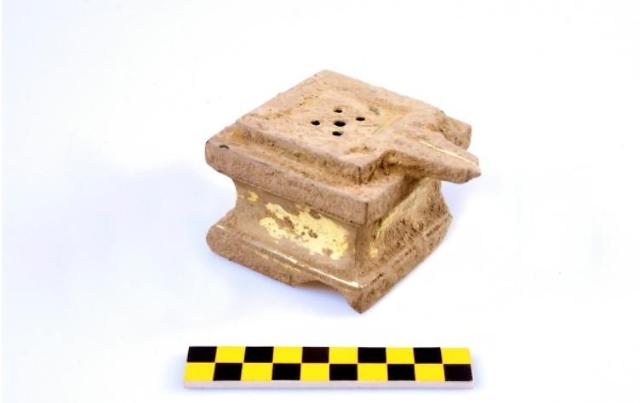
[Courtesy of the Cultural Heritage Administration]
The relic in the form of pedestal was 63mm in height and 110mm in width, the Cultural Heritage Administration (CHA) said Wednesday in a statement. Its material was bronze with the outer surface gold-plated. There are five small holes with a diameter of 3.5 mm on the top with a water spout running along the side, the state body said.
It is presumed to be a religious relic related to Sadha Linga, and Laotian archaeologists confirmed that it was the first discovery of such a relic in the Southeast Asian country, according to the administration.
Yoni, a Sanskrit word that literally means the womb and the female organs of generation, is an iconic representation of goddess Shakti in Hinduism. It is usually shown with its masculine counterpart, linga. Together, they symbolize the merging of microcosmos and macro cosmos, the divine eternal process of creation and regeneration, and the union of the feminine and the masculine that recreates all of existence.
The Shiva Linga or Lingam is a symbol that represents Lord Shiva in Hinduism. As the most powerful of deities, temples are built in his honor that includes a Shiva Linga, representing all the energies of the world and beyond.
The relic was discovered in February in a project to restore and conserve the Hong nang sida temple in Vat Phou, or Wat Phu, a ruined Hindu temple complex where surviving structures date from the 11th to 13th centuries.
From 2013, South Korean archaeologists have been involved in the project funded by ODA (official development assistance), a government aid program to promote the economic development and welfare of developing countries. The complex has a site where a lingam dedicated to Lord Shiva was bathed in water from a mountain spring.
The administration said that the Sadha Shiva religion associated with the yoni relic is an element of ancient cultural exchanges between Wat Phu in Laos and Cambodia's Angkor, the capital city of the ancient Khmer Empire which flourished from about the 9th to 15th centuries.
Angkor houses the magnificent Angkor Wat, one of Cambodia's popular tourist attractions. The Angkor Wat, said to be the world's largest single religious monument, and other temples have been restored, comprising the most significant site of Khmer architecture.
The Shiva Linga or Lingam is a symbol that represents Lord Shiva in Hinduism. As the most powerful of deities, temples are built in his honor that includes a Shiva Linga, representing all the energies of the world and beyond.
The relic was discovered in February in a project to restore and conserve the Hong nang sida temple in Vat Phou, or Wat Phu, a ruined Hindu temple complex where surviving structures date from the 11th to 13th centuries.
From 2013, South Korean archaeologists have been involved in the project funded by ODA (official development assistance), a government aid program to promote the economic development and welfare of developing countries. The complex has a site where a lingam dedicated to Lord Shiva was bathed in water from a mountain spring.
The administration said that the Sadha Shiva religion associated with the yoni relic is an element of ancient cultural exchanges between Wat Phu in Laos and Cambodia's Angkor, the capital city of the ancient Khmer Empire which flourished from about the 9th to 15th centuries.
Angkor houses the magnificent Angkor Wat, one of Cambodia's popular tourist attractions. The Angkor Wat, said to be the world's largest single religious monument, and other temples have been restored, comprising the most significant site of Khmer architecture.


![[영문] Mexico mass grave may be Aztec resistance fighters](https://image.ajunews.com/content/image/2009/02/11/200902110839581620909-2-102089.jpg)
